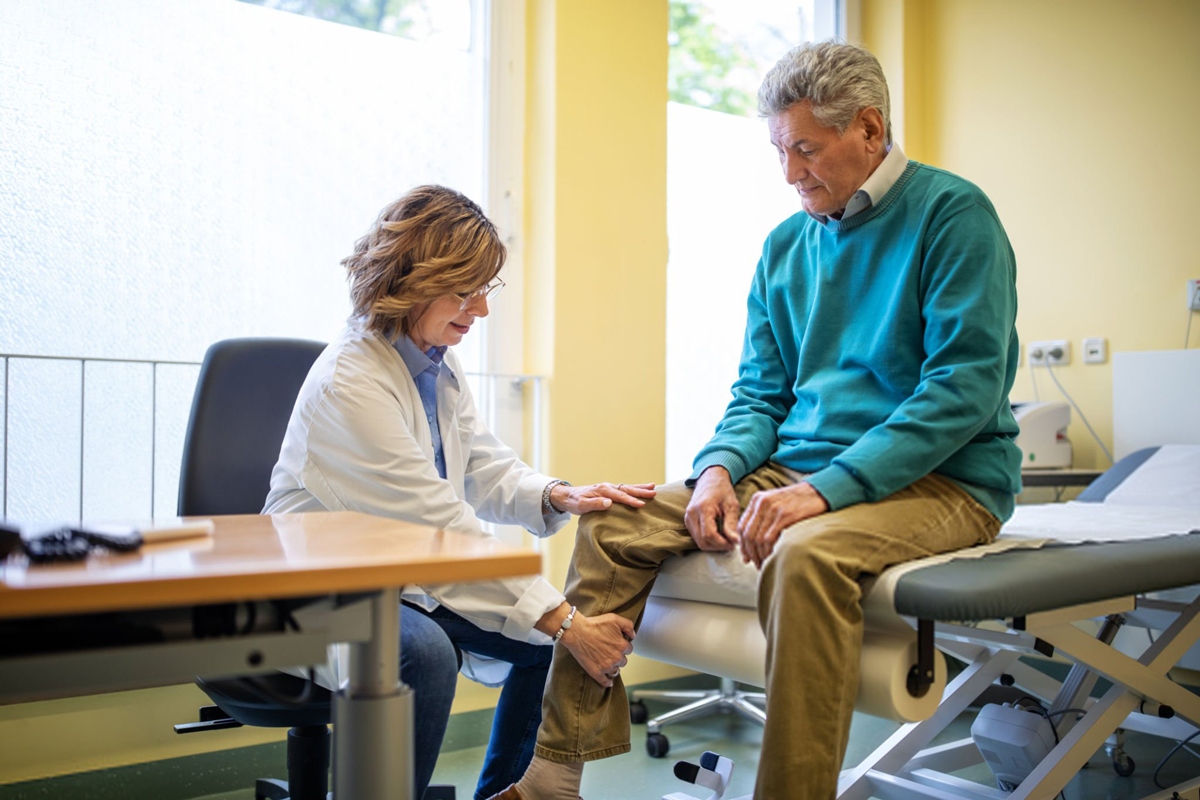McLean is already known throughout the Northeast area for our award-winning healthcare. Equally important is McLean’s nationally recognized outpatient therapy, with our incredible staff of physical therapists. This team, along with our Home Care therapists, is ready to take joint replacement surgery patients through their recovery period. Best of all, it is not just for McLean residents, but also for anyone in the surrounding Simsbury area in need of post-surgical physical therapy.
Local Support from a Trusted Team
Considering the rehabilitation needs of recovering surgical patients, especially those who’ve gone through joint replacement surgery, McLean’s highly trained and experienced physical therapy staff is a great resource. Since you don’t have to be a resident to take advantage of physical therapists like Carla Cuccia, many members of the Simsbury and Farmington Valley community have been able to benefit from their exceptional care.
When asked about her experience providing joint replacement therapy, Carla’s first thought was for her patients. “I think there are some misconceptions about the population we serve,” she says. “Some people are under the impression that we only treat residents, but we support many of the surrounding towns as well.” Local patients visit the outpatient clinic on the McLean campus or access homecare for rehabilitation services.
In fact, among the dozens of physical therapy facilities in the Simsbury area, patients are often willing to make the drive to McLean, even if it means a slightly longer commute. “Part of what really draws people to us,” Carla shares, “is the fact that we not only offer land therapy, but aquatic therapy as well.” Having access to the pool during rehabilitation expands the programming offered and the resulting recovery. “Even if the pool is temporarily unavailable,” she explains, “patients can still benefit from land therapy with incredibly professional staff.”
Experienced Physical Therapists
What separates this team from others in the area is the level of experience they bring to the table. Not only in terms of physical therapy and joint replacement therapy, but also based on their tenure at McLean. “Most of our therapists have an extensive history here. They’ve worked within the community for 20 or 30 years,” Carla says. As a result, they’ve been able to enhance the programs with their input. “Now, we have anything and everything you could potentially need for rehabilitation.”
“If you think about equipment as a major part of physical therapy, one of the most important tools we have is our hands,” she explains. Although she’s one of the younger therapists on staff today, she’s carrying on the tradition of continuing education. For patients looking to recover post-surgery, the team’s extensive knowledge of hands-on manual therapies is a strong differentiator—whether they’re participating at home or in McLean’s outpatient clinic.
Post-Surgical Steps
What are the different forms of post-surgical joint replacement therapy and how do they come into play? According to Carla, it depends on the situation. “Inpatient therapy can be the first step, but now most surgeons may authorize you to go home shortly after the procedure. If not the same day, then often by the next,” she shares. “With such a quick turnaround, many patients are receiving home care services instead.”
“However, if you can’t go home for any reason, you may need to go to an inpatient facility specifically for short-term rehabilitation,” Carla says. This is a viable option for people who would otherwise not be able to get the care and support they need at home. In addition to physical and occupational therapy, patients can access skilled services from nurses. “In that setting, you’re probably going to be receiving therapy twice a day, five to six times a week.”
How long you remain in this facility is ultimately determined by the doctor and patient, along with the inpatient staff, but when it’s time to return home, therapists like Carla can step in to assist in your recovery. “With home care, it’s all about making sure your transition is completed safely. One of the first things we do is a home assessment to ensure you have everything you could possibly need to continue rehabilitation in comfortable, safe environment.” We consider all the different rooms of a house, from bathroom(s) to bedroom(s) and everywhere in between. If there’s any equipment that would make your life easier, they suggest it. “After that, we work,” she explains.
Top Joint Replacement Tips
Continuing to explain McLean’s continuum of care, Carla says, “If you have a joint replacement, we focus on getting your range of motion, strength and balance back.” The physical therapists will guide you through strengthening exercises designed to keep you active. Once it is no longer taxing to leave the home, often in a period as little as one or two weeks, they can transition from comprehensive home care to outpatient treatment. “At this point, we’re concentrating on the joint that’s been operated on, making sure the patient gets to 100% mobility, strength and stability and have returned to a similar level of function as before the joint replacement.”
So, what tips do Carla and her team have to help you prepare for upcoming joint replacement therapy? We can separate them into two main categories.
BEFORE
- Know the expected length of recovery that includes both post-operative care and rehabilitation time.
- Know if there will be any precautions and/or restrictions following your replacement.
- Know what the average pain level for the first few weeks following your replacement will be and how it will it be managed.
- Know the type(s) of medical equipment needed following your replacement.
- Ask if there are any exercises that would be beneficial to do pre-operatively.
- Know what type of closure will be used for your incision and what type of care it will require.
AFTER
- The pain you feel for the first hours after your surgery may be masked by the peripheral nerve block used during your surgery.
- Therapy will start as soon as possible, sometimes even on the same day of your surgery.
- There will be swelling that may extend beyond the joint that was replaced. Follow your discharge instructions on how to best control it.
- Likely due to pain, your sleep pattern will be affected. To minimize this effect and stay ahead of the pain, take all prescribed medication as directed.
- Compliance with your therapy program is integral to achieving the best recovery outcome.
All Because We Care
While the team is busy making sure McLean residents have what they need to live their best lives, the community does the same for staff. Carla explains the team’s loyalty and longevity with a brief anecdote. “When COVID-19 first hit, we temporarily closed the outpatient clinic. But because McLean is such a great company, they kept us employed by providing other opportunities for us to help elsewhere in the building doing anything and everything we could to help residents and staff. McLean is really there for you. I mean, how many companies would do that for their employees?”
This sense of responsibility to our healthcare employees is not only a large part of the reason for the retention of an incredibly well-respected physical therapy staff, but also the reason patients recovering from surgery throughout the Simsbury area, including those recovering from joint replacement, know they’re in great hands with the team at McLean.
For more information on our senior rehabilitation services, please complete the request form. You can also reach us by phone. For outpatient rehab, call 860-658-3745 or 860-658-3901 for inpatient therapy.


